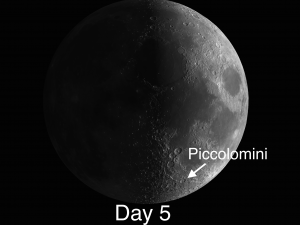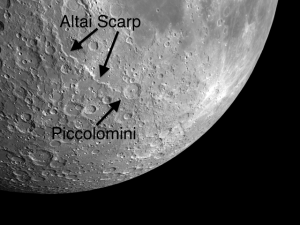The week of February 27-March 5 takes us from Day 1 through Day 7. Thursday through Sunday evenings are prime Moon-viewing times! This week we will highlight the crater Piccolomini, viewable on Friday evening.

Piccolomini: [SE/M13] The Altai Scarp (highlighted in the October 3rd blog) terminates on its southern end at Piccolomini, a 55-mi.-in-diameter crater. It is a beautiful and complex object with a substantial central mountain peak, terraces, and a smooth convex floor. Notice how there is a great deal more turmoil around the southern rim of Piccolomini. Can you see the tiny craterlet just touching the northwest base of the central mountain?
OF ADDITIONAL INTEREST THAT MOON WATCHERS CAN VIEW DURING LUNAR DAYS 1-7:
Mars and Uranus are in the constellation Pisces and on Monday evening they will both fit into the same low-power eyepiece, providing it has a field-of-view of at least 1°. Look for the two planets 11° to the upper left of bright Venus over the western horizon. Don’t expect much in the way of detail. Mars is only 4.6 arc-seconds at magnitude +1.3, and Uranus is 3.4 arc-seconds at magnitude +5.9. This technically makes Uranus a naked-eye object if you have good eyesight and very dark skies, but the tiny point of light was not discovered to be a planet until 1781 when Sir William Herschel stumbled upon it with his telescope. (He later coined the term “planetary nebula” because through a telescope such an object resembled Uranus. After observing Uranus with a higher power, go to the Eskimo Nebula in Gemini to check out the similarity between the two.)
======================
It is highly recommended that you get a copy of Sky and Telescope’s Field Map of the Moon, the very finest Moon map available for use at the telescope. It is available for $10.95 at www.skyandtelescope.com and on Amazon. All features mentioned in this blog will be keyed to the grid on the Field Map and will look like this: Plato: [NW/D9]
Credits:
Courtesy of Gray Photography of Corpus Christi, Texas
Lunar photos: NASA / USGS / BMDO / LROC / ASU / DLR / LOLA / Moon Globe. Used by permission
- Rupes Cauchy: A Best Known Fault on the Moon - July 22, 2024
- Moon Crater Schickard – Crater Floor has Stripes - July 15, 2024
- Moon Craters Langrenus and Vandelinus - July 8, 2024
